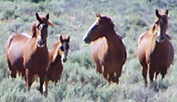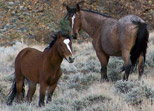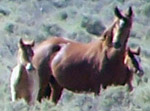
Loading Menu...
|
||
|
Myths and Facts
Most of the wild horses & burros that roam our public lands are descendants of the horses who helped the pioneers settle the American West. Others came over with the Spanish in the 15th & 16th centuries. But the DNA of all wild horses & burros around the world originated in North America. Horses & burros inhabited North America, their "cradle of evolution," for nearly 60 million years, as did all other members of the horse family, Equidae. Though some educated authorities claim the horse disappeared several thousand years ago, this has been called into question by some noted biologists and paleontologists who point to fossil and other evidence indicating they were never completely absent from North America. (You can read Chapter I of The Wild Horse Conspiracy as an eBook preview.) Even if you assume that the modern horse vanished for a few to several thousand years, this would be a drop in the bucket compared with its vast ascent in North America. Remember the wise American Indian saying: "the grasses remember the wild horses."
This is utterly false! Such propaganda has been created by groups of ranchers, hunters and others opposed to keeping wild horses & burros in the wild. However cleverly disguised, this is not motivated by a quest for greater ecological health but to satisfy greedy interests aimed at exploiting nature. Forgotten is the natural place of the returned native horse and burro in North America & the many ecological services they offer, as seminomadic, postgastric digesters.
In order to try to substantiate their false claims, many wild horse & burro enemies, including government officials, take pictures of wild horses & burros while they are roaming through areas in which vegetation, soil, streams & riverbanks have been degraded by cattle & sheep. Then these individuals present their pictures as "evidence" that wild horses & burros are damaging the ecosystem. Who really is causing the massive damage to our public lands ecosystems? Is this the few tens of thousands of wild horses & burros with their postgastric digestive systems that restore the soils & seed many species of plants and who are perfectly suited for the vast, open regions of North America, especially the West? They constantly move about, often roaming hundreds of miles in a week, more evenly distributing their grazing pressure than do domesticated cattle & sheep. Is it not rather the many millions of cattle & sheep who are given the hog's share of the forage on the vast majority of our public lands, including in the very areas that are principally designated for wild horses and burros? Possessing no upper incisors, bovid cattle & sheep often rip the grasses & other herbs from the ground using their tongues, lower teeth and hard upper palates, and the animals often cluster in large numbers in areas near streams or lakes, resutlting in overgrazing, overtrampling and pollution. As the architects of the Wild Horse & Burro Act of 1971 recognized, the carrying capacity for wild horses on our public lands is relatively high. As recently as 1980, the total number of wild horses & burros was 60,000, but due to subterfuge, this relatively small number was branded as overpopulated and targeted for drastic reduction, precisely because wild horse & burro enemies were placed in charge of our nation's wild horse & burro program. When the Act was signed into law, there were about 34,000 wild horses & burros in the United States. This was when Americans of all stripes justifiably considered them in grave danger of disappearing from the American landscape. Including citizen activists such as Wild Horse Annie, wildlife ecologists & statesmen, the Act's conceivers knew our lands could easily support hundreds of thousands if not millions of wild horses & burros. More specifically, the conceivers sought to design and allocate manageable Herd Areas or Territories that would support long-term viable, naturally adapted & balanced wild horse & burro populations. Our nation's wild horse & burro program was to be based on a scientific evaluation known as Soil-Vegetation Inventory Method (see pp. 65 - 66 of The Wild Horse Conspiracy); and biologists were in the process of fairly identifying carrying capacities for each of the Herd Areas and Territories. However, when Ronald Reagan became President, this benign program was destroyed by indivdiuals who had no love for the horses and burros living freely in the natural world nor for restored, wild-equid-containing ecosystems.
Mountain lions, wolves & bears prey upon wild horses and burros, and coyotes are known to take very young, aged or sick individuals. But these predators have been targeted for elimination or have been reduced to endangered population levels. This is usually done to prop up the public lands ranchers and hunter "harvests." Yet, in places like the Montgomery Pass wild horse territory in California's Inyo National Forest and Arizona's Cerbat wild horse herd area, puma & other predators naturally limit wild horse populations. Such limitation has also been observed with the Pryor Mountain wild horses, of PBS-TV Cloud series fame. Basically, food, water, shelter & other habitat requirements naturally limit a wild horse or burro population, provided we people have the wisdom & patience to allow these animals to fill their respective niches and stabilize their numbers as climax species do (See Chapter IV of The Wild Horse Conspiracy). Because of natural checks operating in nature, wild horses and burros can stabilize and come to a harmonious balance within their life communities. Of course, this totally contradicts the misleading, hysterical claims by wild horse & burro enemies that wild horses and burros multiply uncontrollably, like the boom-and-bust lemming, a subclimax species. Sheer prejudice lies behind the draconian roundups today. One or more helicopters stampede terrified horses or burros, pushing them to run for several to many miles, causing them to smash their hooves, bones and muscles on uneven, rocky terrain or to fall into ground-squirrel holes and break their necks. Finally these frantic, desperate animals are driven into small metal corrals; and it is common for the horses & burros, including pregnant mares & foals and the old or young to be badly injured and even killed in the process. United States Bureau of Land Management officials often minimize this suffering; and far more than the reported 2 percent of the animals are killed, especially if we take into consideration subsequent depression, injury & disease in the holding pens.
Using such clever words, wild horse & burro enemies seek to deny the wildness of the animals and to cast them more as mere creations of mankind, as though their multimillion year presence and development in the wild and as striving contributors to life's evolving ecosystems did not matter. Keen naturalists have long noted that horses & burros quickly revert to the wild as their age-old instincts revive and that the animals can become thoroughly adapted to a wild ecosystem within a generation or two, provided people leave them and the ecosystem alone! Yet, the millions of cattle & sheep ranchers put out in unnatural excess to graze on our public lands at taxpayers' expense are all nonnative! They were brought over from the Old World and have not been in North America for as long as horses & burros have been. Ruminant digestive systems are overburdened in many of the dry regions in the West, as the more tender vegetation preferred by cattle & sheep becomes more and more scarce. Wild horses & burros, however, possess postgastric digestive systems more suitable for consuming coarser, drier forage. Hence cattle often camp in moist areas near streams and lakes, wreaking ecological havoc. These riparian habitats are known as "the lifeblood of the desert." The reality is that wild horses & burros know their homelands very well and are incredibly innovative at finding sources of food & water. Nonetheless, wild horses & burros are "set up" for failure, because greedy people & their government puppets have finagled to deprive them of life-sustaining resources, i.e., food, water, shelter, etc., in order to further public land monopolies by ranchers, big game hunters, miners, energy extractors & other resource exploiters within areas set aside for wild horses & burros. This violates the law! The massive numbers of livestock and members of big game species grazing on public lands are seldom spelled out, especially within the wild horse & burro Herd Areas and Territories. The Bureau of Land Management (BLM) does not provide the total number of cattle & sheep, and neither does the livestock industry provide current and accurate numbers. How so, since corporations almost invariably keep close tabs on their products and resulting profits in order to help stay afloat? Very revealing figures can be obtained by pertinaciously searching government, private & academic sources. (See relevant figures and discussion in The Wild Horse Conspiracy.)
Those familiar with the livestock industry on our public lands estimate ca. eight million cattle and a dozen or more million sheep grazing annually, including those on BLM, United States Forest Service, National Park Service, Fish & Wildlife Service & state lands. A more logical way to look at this involves relative grazing pressure as measured in Animal Unit Months (AUMs), or what a cow and her calf consume in one month, or five sheep, or one horse. For example, on BLM public lands, grazing privileges allocated to livestock total about eight million AUMs on more than 163 million acres. This is the equivalent of about 660,000 cows grazing year-round. If there are 30,000 wild horses & burros on these same lands, there exists a ratio of 22 to 1 as far as livestock grazing pressure relative to wild equid grazing pressure. And on Forest Service lands this ratio is even more imbalanced in favor of livestock. Here, contrary to the law, wild horses and burros have been almost entirely zeroed out. (See pp. 86 - 87 & 137 - 138 in The Wild Horse Conspiracy.) Wild horse & burro enemies use their massive economic & political influence to subvert wild horses & burros through an ongoing public relations campaign. These individuals aim to confuse & misinform the American public concerning these animals. The individuals coerce government officials into disobeying the Wild Horse & Burro Act and pressure them to systematically eliminate or cripple every single one of our nation's last remaining herds. Each herd has adapted over many generations to a unique habitat, constitutes a national heritage that should also be protected by the National Historical Preservation Act, and preserves the true vigor of the horse or burro species, thus enabling it to survive into the future. Given that all eight species surviving as wild populations in the horse family are threatened or even endangered, preserving wild horses & burros here in their "cradle of evolution" is of paramount importance to the future of Earth's balanced life community. (See Chapter I of The Wild Horse Conspiracy.) |
Support Our Work Make a tax-deductible contribution to the Wild Horse and Burro Fund so that we can continue conducting research, education and outreach. Get Involved Sign up to receive our Action Alerts. Purchase a copy of The Wild Horse Conspiracy by Craig Downer. Watch Craig Downer discuss the book and his reasons for writing it. "If man is not to stifle human feelings, he must practice kindness to animals, for he who is cruel to animals becomes hard also in his dealings with men. We can judge the heart of a man by his treatment of animals." - Immanuel Kant |
|

|
||




